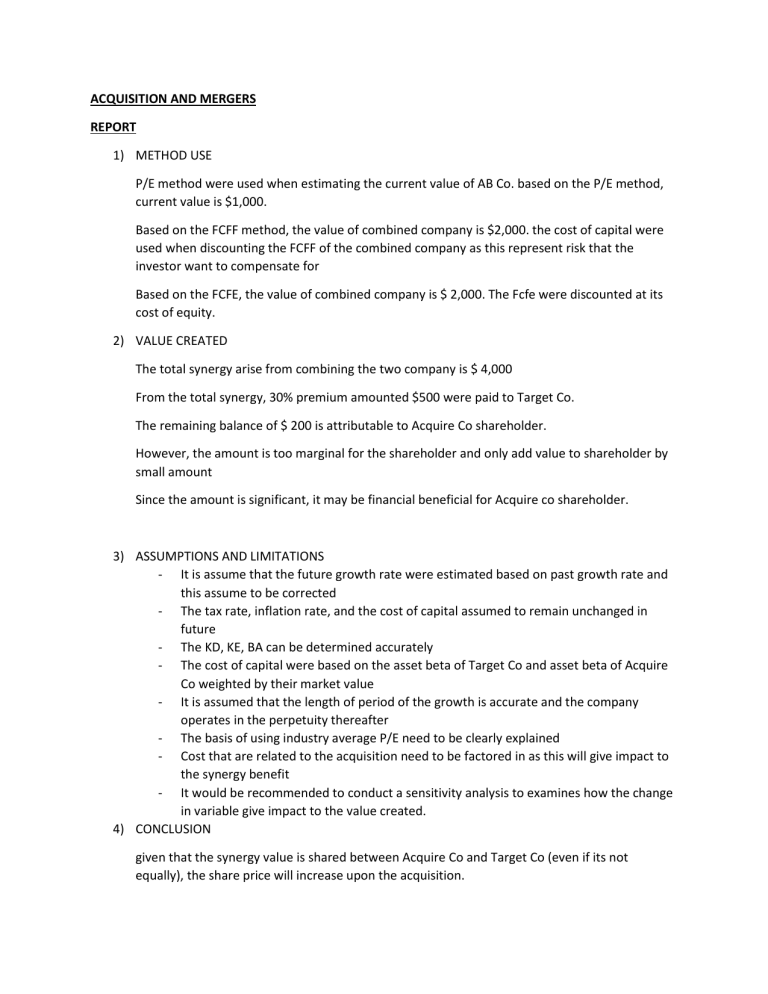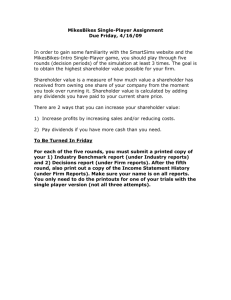
ACQUISITION AND MERGERS REPORT 1) METHOD USE P/E method were used when estimating the current value of AB Co. based on the P/E method, current value is $1,000. Based on the FCFF method, the value of combined company is $2,000. the cost of capital were used when discounting the FCFF of the combined company as this represent risk that the investor want to compensate for Based on the FCFE, the value of combined company is $ 2,000. The Fcfe were discounted at its cost of equity. 2) VALUE CREATED The total synergy arise from combining the two company is $ 4,000 From the total synergy, 30% premium amounted $500 were paid to Target Co. The remaining balance of $ 200 is attributable to Acquire Co shareholder. However, the amount is too marginal for the shareholder and only add value to shareholder by small amount Since the amount is significant, it may be financial beneficial for Acquire co shareholder. 3) ASSUMPTIONS AND LIMITATIONS - It is assume that the future growth rate were estimated based on past growth rate and this assume to be corrected - The tax rate, inflation rate, and the cost of capital assumed to remain unchanged in future - The KD, KE, BA can be determined accurately - The cost of capital were based on the asset beta of Target Co and asset beta of Acquire Co weighted by their market value - It is assumed that the length of period of the growth is accurate and the company operates in the perpetuity thereafter - The basis of using industry average P/E need to be clearly explained - Cost that are related to the acquisition need to be factored in as this will give impact to the synergy benefit - It would be recommended to conduct a sensitivity analysis to examines how the change in variable give impact to the value created. 4) CONCLUSION given that the synergy value is shared between Acquire Co and Target Co (even if its not equally), the share price will increase upon the acquisition. FINANCING METHOD 1) CASH OFFER Target Advantages: - Gives a certain immediate return to shareholder Therefore, it is less risky compare to share exchange Disadvantages: - Premium may be lower compare to share exchange Acquires Advantages: - Acquiring company without the dilution of power With sufficient cash, acquisition can be done quicker Disadvantages: - Large amount of cash used may be a burden for company and may affect company’s ability to invest in a new value created investment in future May deteriorate ability to pay shareholders dividend 2) SHARE FOR SHARE EXCHANGE Target Advantages: - Have shareholding in company, owner of the company Increase shh wealth in probability of higher return Disadvantages: - Uncertain as the it depend on whether the synergy is achievable upon acquisition. Therefore its more risky Acquires Advantages: - Large amount of cash can be retained for investment in other value created project in the future Help to ensure that target shh interest aligned with overall companies strategy, therefore reduce agency issue Disadvantages: - Dilution of control over company percentage gain may be so marginal CITY CODE 1) MANDATORY BID RULES - Provide minority shareholder opportunities to sell their share at a specific share price. - Bidder must offer price at highest, as a minimum, which had been paid by acquirer previously - This is to ensure that majority shareholder does not exploit their power towards minority shareholder 2) PRNCIPLE OF EQUAL TREATMENT - This principles stipulates that all shareholder’s group terms must be equal with other group of shareholders - No group terms is less or more favourable than the other group - This is to ensure that minority shareholder will receive the same level of benefit as previous shareholder 3) SQUEEZE OUTRIGHT - Allows acquirer to force minority shareholder to sell their shares at specific fair share price, once they have acquire certain percentage of shares in that company - this to ensure that acquirer gain 100% stake in target to prevent any problem arise by the minority shareholder at a later date DEFENSE STRATEGY 1) CROWN JEWELS - Strategy where company dispose its valuable asset in order to make company less attractive to the bidder - However, such move must need shareholder approvals - If the fund raise use to invest in another value created investment that could enhance shareholder wealth, shareholder may accept the decision. - If there is no profitable investment available, shh may prefer the fund raised to be returned to them through a special dividend or a share buy back. - However, if the fund is retained and not used to enhance their value, they might reject such decision. - If disposing the asset still make company attractive to bidder, for example, if the fund raised return to shh make company smaller and become more affordable to the bidder, then such decision may be not a feasible defense strategy 2) POISON PILLS - Gives existing shareholder the opportunity to purchase additional shares issue at a discount price. - This to make company more expensive in that bidder need to purchase more shares to acquire 3) GOLDEN PARACHUTE - Gives large amount of cash or bonus to existing managers as a compensation for losing their position after the acquisition. - However for listed company, they need to have remuneration committee to review the remuneration package - The rationale of paying high remuneration need to be explain or else shareholder may think that this is for their own interest, thus may reject such decision - This strategy may be ineffective if the bidder decide to retained managers and felt that such amount is reasonable to compensate them RISK DIVERSIFICATION - Risk diversification would enhance value in a situation where the shareholders exposed to systematic and unsystematic risk For example shareholder who does not hold a well diversified portfolio is exposed to unsystematic risk as they are only concentrated their investment in company In such situation, diversification would reduce their risk and therefore enhance their value For investor who alredy hold a well diversified portfolio, such as institutional investor,they are not hold well diversified portfolio. further diversification will not enhanced their value. Instead, company should focus in its core business, where they have expertise. REVERSE TAKEOVER - Reverse takeover occur when small unlisted company acquire large unlisted company through share for share exchange. Large unlisted company will obtain listing without going through IPO process Initially, large unlisted company will take over shell listed company by buyig some shares in that company Sehll listed company is probably a normal listed company but is no longer trading New equity in shell listed company will be shared with the unlisted company Externaly, it looks like the shell listed company has acquired the unlisted company But in reality, the unlisted got listing and take over control of the shell listed company Advantages: - Speed: normal IPO usually take about 1-2 years to obtain listing. But with reverse takeover, it only took a few months Cost: reverse takeover does not incurred advertising and underwriting cost. A reduction in cost could lead to a greater synergy Confidence: increase shareholder confidence and other potential shareholder to invest in that company is highly regulated upon listing Disadvantages: - - - Risk: there is a risk where listed company that being used to facilitate reverse takeover has unclear liabilities in financial statement and this could impact the overall company after the takeover Expertise: once listed, a company will be needed a high understanding on regulatory procedures. Fail to do so may make company fail to comply with listing rulesand if this become publicise, will affect company reputation Reputation: reverse takeover often seems as poor man IPO and therefore it is less favourable as compare to normal IPO. TYPES OF SYNERGY - - Unlock company value: identifying undervalue company where the management is not effective at unlocking their value. By replacing the existing manager, acquirer can unlock the company true value. Economie of scope: eliminate process duplication, thus increase efficiency Market share: acquiring business in the same line may increase company market share and lead to be market leader Cash surplus: eg-target company is struggling in raising fund to develop its innovative product. Acquirer is an establish company but lack of innovation. This could be advantages for the target as they could use the cash spare in the acquirer to develop the product and acquirer could use their innovative ideas for the new product. REASON FOR LISTING - Use fund raise to eliminate debt in the company Gaining high reputation since it is listed in the stock exchange and highly regulation therefore reduce the cost for contracting with stakeholders Enable current owner to sell their equity stake and gain from the value of the organization. Easily to raise fund in the future in that finance provider will have higher confidence since we are highly regulated.



